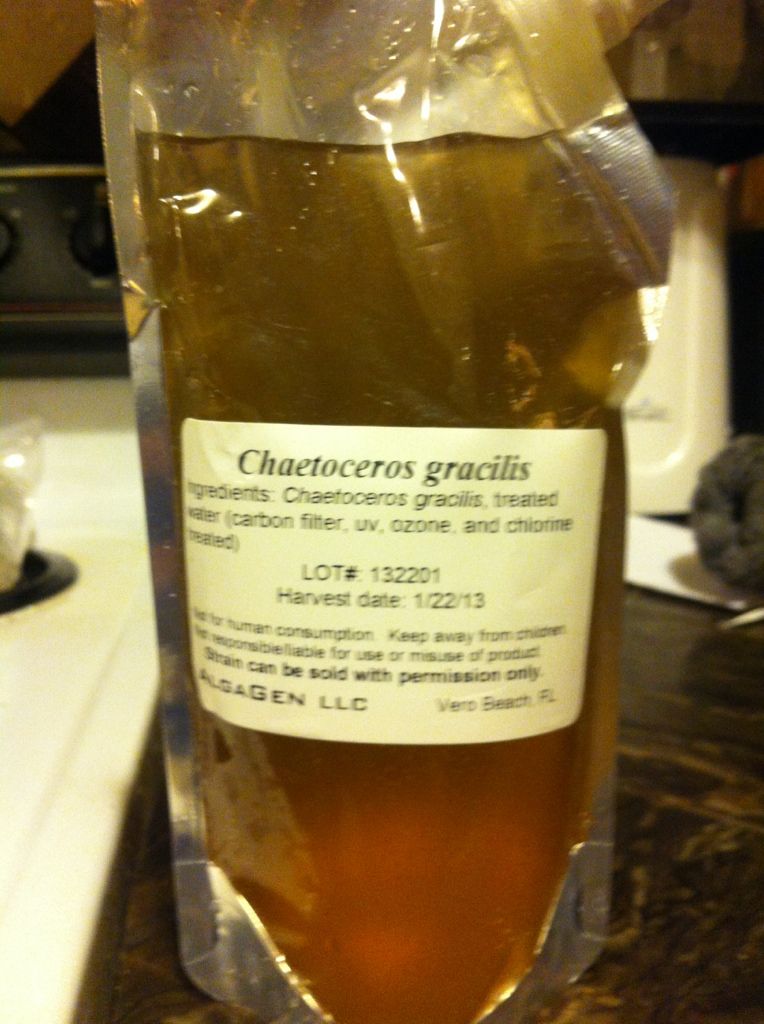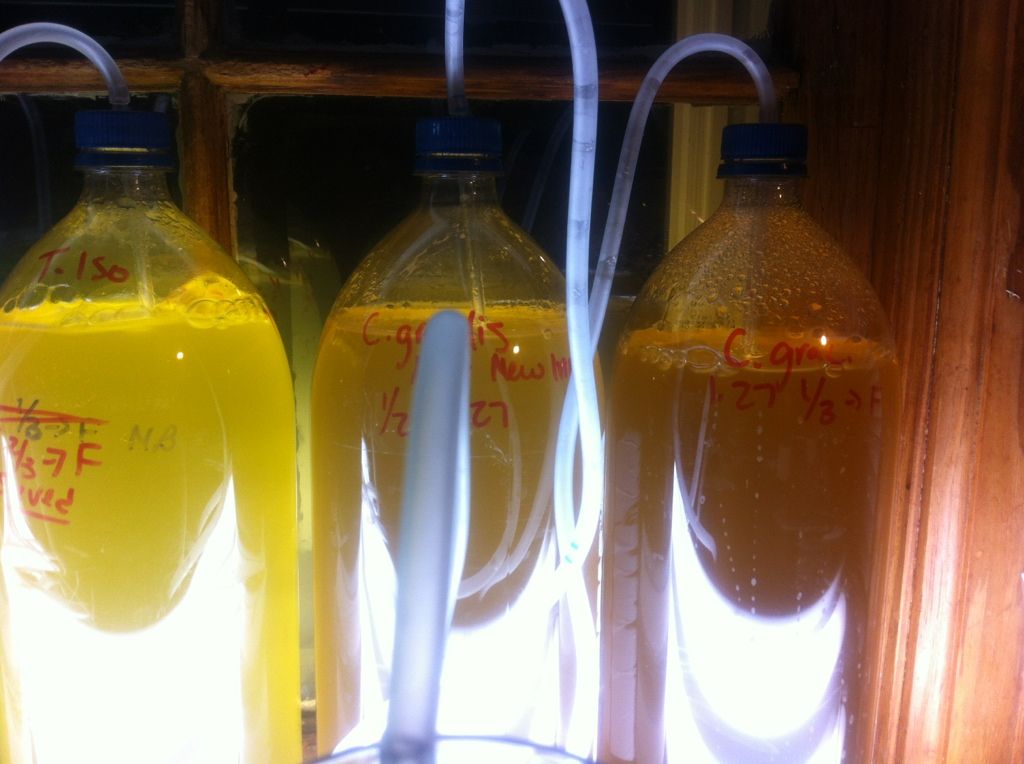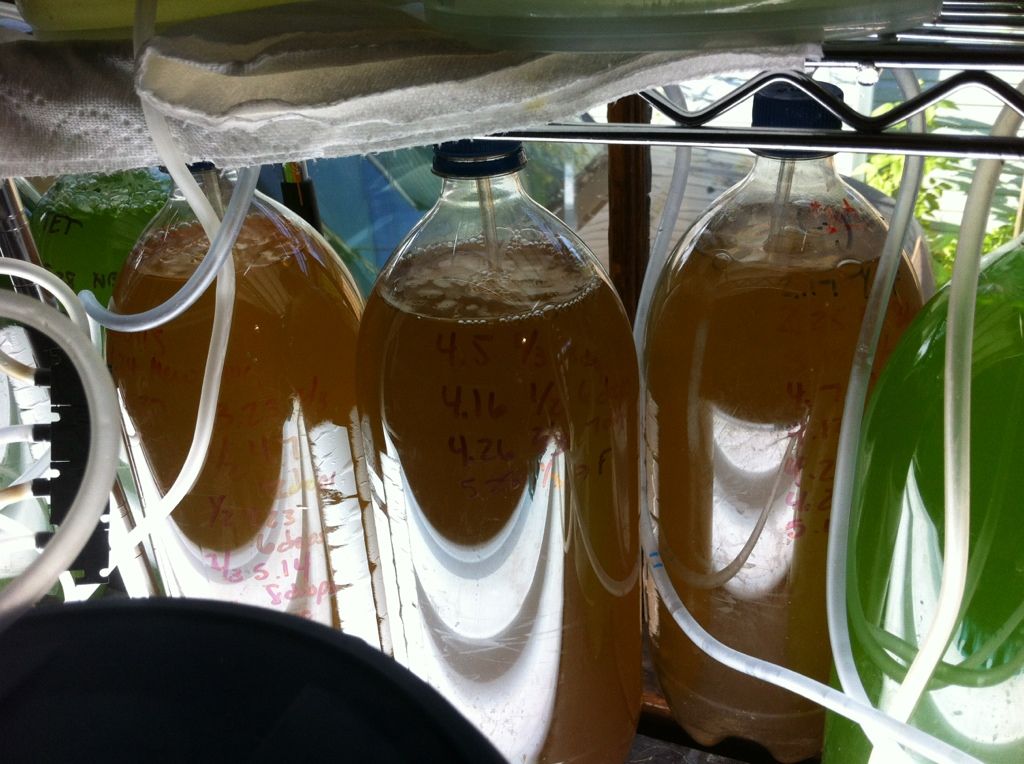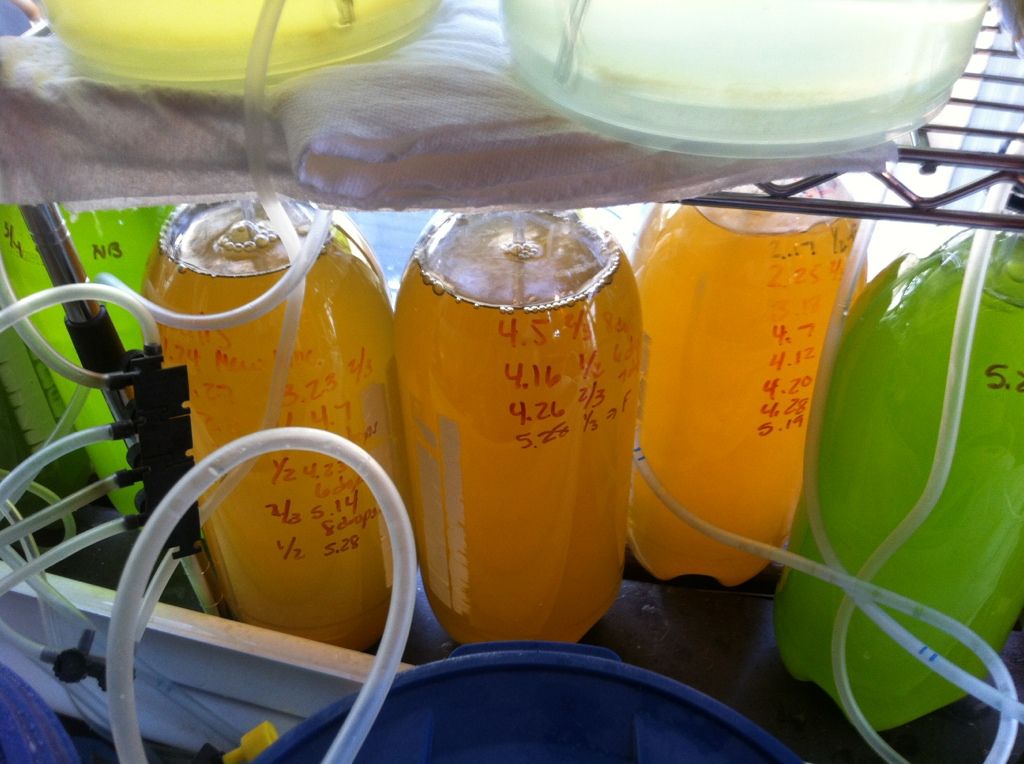Change Page: 12 > | Showing page 1 of 2, messages 1 to 20 of 25 - powered by ASPPlayground.NET Forum Trial Version
Reports tied to this Journal
Author
|
Message

|
 Culture Journal, Species: Chaetoceros muelleri (aka C.gracilis)
Tuesday, January 29, 2013 3:39 PM
Culture Journal, Species: Chaetoceros muelleri (aka C.gracilis)
Tuesday, January 29, 2013 3:39 PM
( permalink)
Culturing Journal DataSheet
This first post should be updated regularly to include new information as events take place or changes are made to your system General Species: Chaetoceros muelleri (aka C. gracilis) Species description: (Taken from Seahorse Source) This is a diatom and requires f/2 media + silica as a feed. It favors hi-light. It contains other fatty acids such as ARA and has been a standard in shrimp and bivalve farming. Also a hearty cell. Temperature range: 65º-81º F (18º-27º C). Approximate cell size: 4-10 µ wide by 4-9 µ long. Culture source (link if possible ): Seahorse Source http://www.seahorsesource...p/detail.cgi?id=201129 If algae, CCMP # (Optional ): http://ccmp.bigelow.edu/ Culture Establishment Date: 1.24.2013 Continuation Date: 4.24.2013 Culturing Vessel Details Salinity: 1.018-1.020 SG Temperature: Room temp, between 68 and 72 F in the winter, warmer in the summer. Cultures kept near window pH: Not measured
Vessel description: 2L soda bottles Lighting description: 2 bulb fluorescent shop light and natural sunlight from a southern facing window. Lighting cycle: 6:30a to 9p Aeration description: Rigid airline, not very vigorous Methodologies Split methodology: Diluted starter culture 1:3 in a single 2L bottle. On day 4 it was split into two 2L bottles which were then filled with sterile, fertilized water. Cultures are split once they reach maximum darkness (gauged by eye). If a culture does not darken up as expected, half is taken and disposed of and new sterilized, fertilized media is added. Culture medium description: 500-600uL microalgae grow per L, 6 "drops" of liquid silicate from FAF per L ( http://florida-aqua-farms...id-silicate-solution/) Cell count: Not measured (if known) Reference links: Additional Information (No Pictures or Videos in the Section Please) Notes: Water is taken from broodstock tanks and sterilized with 1/2mL per L of bleach for minimum of 1hr, then neutralized with 1.5 mL per L of 1M sodium thiosulfate. You will be required to provide photographic evidence and as much detail as possible about your project in this thread.
If your thread does not contain detailed enough photos and information the MBI Council will not be able to approve your reports.
<message edited by shannpeach on Thursday, May 30, 2013 9:01 AM>
|
|
|
 Re:Culture Journal, Species: Chaetoceros gracilis
Tuesday, January 29, 2013 3:44 PM
Re:Culture Journal, Species: Chaetoceros gracilis
Tuesday, January 29, 2013 3:44 PM
( permalink)
The starter culture:  A couple days after the initial split (C. gracilis is in the two far right hand bottles)  This is my first diatom so wish me luck 
|
|
|
 Re:Culture Journal, Species: Chaetoceros gracilis
Tuesday, January 29, 2013 5:59 PM
Re:Culture Journal, Species: Chaetoceros gracilis
Tuesday, January 29, 2013 5:59 PM
( permalink)
Cool! Good luck. What are you going to feed it to?
|
|
|
 Re:Culture Journal, Species: Chaetoceros gracilis
Tuesday, January 29, 2013 6:15 PM
Re:Culture Journal, Species: Chaetoceros gracilis
Tuesday, January 29, 2013 6:15 PM
( permalink)
I have a few different types of pods that I will use it for, but I mainly wanted a diatom species because I read a couple papers about copepod culturing that said to use a diatom in combination with other phytos. I am hoping that this time around I can keep parvo going. I also have acartia, tisbe, and tigriopus (possibly with pseudocyclops sp. in that culture too). I have been culturing tet and t-iso for most of the pods and my rotifers up until now.
|
|
|
 Re:Culture Journal, Species: Chaetoceros gracilis
Tuesday, January 29, 2013 7:06 PM
Re:Culture Journal, Species: Chaetoceros gracilis
Tuesday, January 29, 2013 7:06 PM
( permalink)
You are correct -- a mixture of different algae is generally preferable over a single species. It also appears to be helpful if the different algae have significantly different cell sizes: http://bit.ly/TTOYNc. Note that in that study, they were using algal densities more like those found in nature, such as around 5,000 cells/ml for Iso, rather than those used in intensive culture protocols. With diatoms, the spines on the diatom may make the cells appear to the copepod to be larger than they actually are (which might be a good thing): http://bit.ly/WzNxyU. You might also find this paper interesting: http://bit.ly/TkgYZY. I'd be interested in knowing which papers you are referring to. As you might have inferred, I'm actively building my copepod culture scientific paper library these days!
|
|
|
 Re:Culture Journal, Species: Chaetoceros gracilis
Tuesday, January 29, 2013 10:11 PM
Re:Culture Journal, Species: Chaetoceros gracilis
Tuesday, January 29, 2013 10:11 PM
( permalink)
I will try to find the papers tomorrow when I can get on the computer. And I will look over the papers you gave links to 
|
|
|
 Re:Culture Journal, Species: Chaetoceros gracilis
Tuesday, February 19, 2013 11:51 AM
Re:Culture Journal, Species: Chaetoceros gracilis
Tuesday, February 19, 2013 11:51 AM
( permalink)
Took me awhile, but I found the one paper that was definitely at the top of my brain for the better copepod culture with a diatom species: http://onlinelibrary.wiley.com/doi/10.1111/j.1365-2109.2011.02919.x/pdf I feel like the other papers I had come across were ones it seems you already have, although I haven't had time to read them all in depth (I had to do a bit of reading for work related stuff to get ready for a presentation). The C. gracilis/muelleri is doing well so far. It needs to be split about every 4 to 5 days. I now have 3 bottles of it going.
|
|
|
 Re:Culture Journal, Species: Chaetoceros gracilis
Monday, April 15, 2013 10:42 PM
Re:Culture Journal, Species: Chaetoceros gracilis
Monday, April 15, 2013 10:42 PM
( permalink)
|
|
|
 Re:Culture Journal, Species: Chaetoceros gracilis
Monday, April 15, 2013 10:48 PM
Re:Culture Journal, Species: Chaetoceros gracilis
Monday, April 15, 2013 10:48 PM
( permalink)
Nice images! I can even see the setae. Good work! Just a few more days for culture continuation.
|
|
|
 Re:Culture Journal, Species: Chaetoceros gracilis
Monday, April 15, 2013 10:57 PM
Re:Culture Journal, Species: Chaetoceros gracilis
Monday, April 15, 2013 10:57 PM
( permalink)
Thanks  It was actually a pain to get them simply because I have three dogs and I swear everytime I would get it focused one of them would jump or flop onto the ground or start scratching themselves so hard it seemed the the entire house would shake. Next time I may just try to get the pics when they are all outside playing or something. So far, at least for me, this has been a relatively easy species to culture. It seems quite forgiving in terms of how much fertilizer and/or silica added, how infrequently it is split or how aggressively it is split. It sort of crashes slowly, and as long as you get it before it is completely clear, it comes back well (I usually let a bottle crash at some point so I get an idea of how dark it can get before NEEDING to be split). All in all, I would recommend this species for anyone interested in trying a diatom.
|
|
|
 Re:Culture Journal, Species: Chaetoceros gracilis
Thursday, May 30, 2013 8:48 AM
Re:Culture Journal, Species: Chaetoceros gracilis
Thursday, May 30, 2013 8:48 AM
( permalink)
Well, I am about a month or so past the continuation date and here are a couple photos of the cultures taken this morning. The first is the cultures lit from the front with the fluorescent strip light, and the second is without the fluorescent strip light, so just natural sunlight from the window.
  As you can see from the dates on the bottles themselves, I let one go over thirty days without splitting/harvesting and it never completely crashed out... so this really is a good phyto to work with for those interested in trying a diatom that isn't too picky 
|
|
|
 Re:Culture Journal, Species: Chaetoceros gracilis
Thursday, May 30, 2013 12:35 PM
Re:Culture Journal, Species: Chaetoceros gracilis
Thursday, May 30, 2013 12:35 PM
( permalink)
Nice work! How much air do you give your Chaeto? It looks like mild to moderate air, rather than a roiling boil from the pictures -- am I right? Chaeto always has a tendency to clump up on me, but I think it's because I give it too much air.
|
|
|
 Re:Culture Journal, Species: Chaetoceros gracilis
Thursday, May 30, 2013 12:40 PM
Re:Culture Journal, Species: Chaetoceros gracilis
Thursday, May 30, 2013 12:40 PM
( permalink)
Mild to moderate would be a good description...it definitely isn't a rolling boil. I haven't had it clump up on me yet and the bottles I culture in don't get gooped up the way other culture bottles do. I don't have to wash the bottles in vinegar to clean the sides, can just rinse it with water (and then sterilize, of course)
|
|
|
 Re:Culture Journal, Species: Chaetoceros gracilis
Thursday, May 30, 2013 6:09 PM
Re:Culture Journal, Species: Chaetoceros gracilis
Thursday, May 30, 2013 6:09 PM
( permalink)
yea i like working with cheatoceros ive let mine go to the point of where it was almost the color of dark brown chocolate before.
this stuff is very easy to work with.
i might have to try and take my air down a notch as like jim mentioned mine does tend to clump up slightly every so often
|
|
|
 Re:Culture Journal, Species: Chaetoceros gracilis
Thursday, June 6, 2013 1:25 AM
Re:Culture Journal, Species: Chaetoceros gracilis
Thursday, June 6, 2013 1:25 AM
( permalink)
got a quick question,
im actually planning on starting a culture on cheatoceros too after trying nano, iso, tet and chlorella ... my question is.. is silica a MUST for cheato? cos its not so easy to get in Hong Kong specially in liquid form) =(
|
|
|
 Re:Culture Journal, Species: Chaetoceros gracilis
Thursday, June 6, 2013 1:29 AM
Re:Culture Journal, Species: Chaetoceros gracilis
Thursday, June 6, 2013 1:29 AM
( permalink)
Yes. Can you get sodium metasilicate crystals? That's what I use.
|
|
|
 Re:Culture Journal, Species: Chaetoceros gracilis
Thursday, June 6, 2013 3:19 AM
Re:Culture Journal, Species: Chaetoceros gracilis
Thursday, June 6, 2013 3:19 AM
( permalink)
Jim,
This is what i can find... is this the stuff??
"Granular Sodium Metasilicate Pentahydrate"~
and if so.. how much do i need?
Real thanks ^^
|
|
|
 Re:Culture Journal, Species: Chaetoceros gracilis
Thursday, June 6, 2013 9:12 AM
Re:Culture Journal, Species: Chaetoceros gracilis
Thursday, June 6, 2013 9:12 AM
( permalink)
Yes, it is the stuff, and you don't need very much at all. One KG will last a VERY long time.
|
|
|
 Re:Culture Journal, Species: Chaetoceros gracilis
Thursday, June 6, 2013 10:28 AM
Re:Culture Journal, Species: Chaetoceros gracilis
Thursday, June 6, 2013 10:28 AM
( permalink)
oh great.... haha 1kg was what i was trying to ask for... hopefully tell sell at that small quantity ^^
|
|
|
 Re:Culture Journal, Species: Chaetoceros gracilis
Saturday, June 8, 2013 10:03 AM
Re:Culture Journal, Species: Chaetoceros gracilis
Saturday, June 8, 2013 10:03 AM
( permalink)
How much Sodium Metasilicate crystals would you add to 2 liter bottle?
|
|
|
|